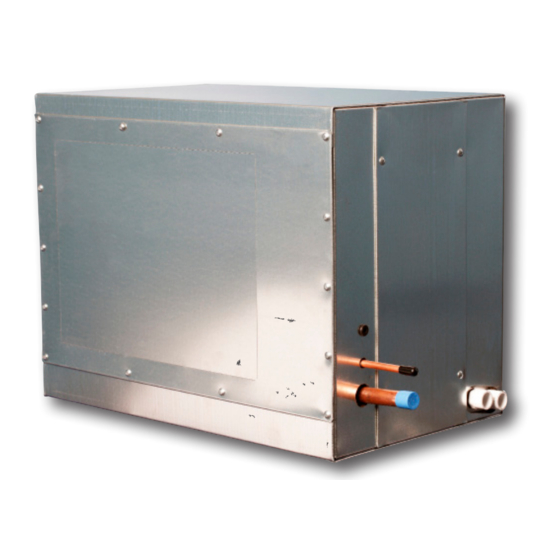Hi-Velocity RPM-E-100 Installation Manual - Page 6
Browse online or download pdf Installation Manual for Control Unit Hi-Velocity RPM-E-100. Hi-Velocity RPM-E-100 8 pages. Refrigerant module

Troubleshooting the TXV
When issues arise that bring the function of the TXV into
question, factors must be looked into before replacement.
Inspect the TXV for signs of damage. This may be from a pinched
equalizer line to a burnt valve. These issues will have an adverse
affect on the operation of the valve. Should the equalizer line be
pinched, the valve will no longer be able to supply the proper
amount of refrigerant to the coil. A burnt valve may have an effect
on the refrigerant charge of the TXV bulb or the seal of the valve.
This may again cause an improper amount of refrigerant to be
metered by the valve or cause the valve head to become seized.
The TXV bulb location and mounting should also be inspected.
The bulb should be securely mounted on the top half of the
suction line. If the bulb is loose or on the lower half of the line, the
bulb will not properly sense the refrigerant temperature and will
not meter the proper amount of refrigerant. Ensure that the bulb
is also properly insulated, as a lack of insulation will expose the
bulb to conditions well outside those of the coil. This will cause an
overfeed of refrigerant to the system.
Should the installation of the valve be proper, and no damage
is evident, inspect the operation of the valve. If the TXV bulb
is removed and held in ones hand, the valve should react
accordingly. This sudden increase in heat will open the valve. This
will cause a rise in suction pressure and a drop in liquid pressure.
Should nothing happen, the valve is likely seized and will need to
be replaced.
Short Cycling
Short cycling is the unnecessary running of the indoor
Specifications
Matching Fan Coil
Part Number
Tons
(1)
Refrigerant Type
TX Cooling MBH
(2)
Latent Cooling MBH
Fin Material
Tubing Material
Type of Fins
Liquid Line (Lq)
Hydronic
Connection
Suction Line (S)
Sizes
Drain Connection
TXV with Built in Check Valve & Bypass
Site Glass
Access Ports
Freeze Stat
Shipping Weight
Module Size (L x W x H)
(1) Minimum of
Minimum of four HE outlets
four HE outlets per ton of cooling needed. (2" Duct = Minimum
per ton of cooling needed. (2" Duct = Minimum eight outlets
(2) Smaller condensers may be matched to the fan coil when needed (match TXV to condenser size)
www.hi-velocity.com
and outdoor unit, on and off. This often takes the form of very
short and frequent on cycles. There are many factors that may
contribute to short cycling of the refrigerant system. These issues
can generally be broken down between airflow related issues,
refrigerant issues, and installation issues.
cycling. As the airflow rate is lowered across the cooling coil, the
coil pressure drops along with it. This lowers the temperature of
the coil and may cause the freeze-stat to trip. As the system settles,
the freeze-stat closes and the cycle begins again, as the unit
does not run long enough for the space to become adequately
conditioned. Ensure that the proper amount of airflow is provided
to the coil. Check for proper air flows and return air practices.
An undercharged system will react much the same as a system
with low airflow. If the charge is low enough, it may trip out on
low pressure. If a system is overcharged, it may trip out on high
head pressure. Ensure that the system charge is within the bounds
described in section "Piping the RPM-E".
Piping practices should be within the bounds described in section
"Piping the RPM-E" and within the realms of the outdoor unit
manufacturer. Extreme and often unnecessary adjustment of
the TXV can create conditions similar to an undercharged coil. A
poorly placed T-stat, such as underneath a vent, can cause short
cycling. This happens due to the T-stat being satisfied very shortly
after the unit has begun to operate.
RPM-E-50
HE-Z/HE-B/HE-50/51
HV-50/51/52
LV-50
20090200050
1.5 - 2.0
(5.3 - 7.0 kW)
R-410A
18-24
(5.3-7.0 kW)
6.8-8.9
(2.0-2.6 kW)
Aluminum
Copper
.006 Al
(0.1524mm)
3/8
"
(9.5mm)
7/8
"
(22.3mm)
3/4
M CPVC
"
(19mm)
Yes
Yes
Yes
Yes
48 lbs
(22kg)
" x 14
" x 18
"
1 ⁄4
5 ⁄8
1 ⁄2
19
(489mm x 371mm x 470mm)
eight outlets per ton)
per ton)
-6-
-6-
Refrigerant Module Installation
Low airflow rates are one of the most common causes of short
Improperly charged systems run the risk of short cycling as well.
System set-up and installation should be checked as well.
RPM-E-70
HE-Z/HE-B/HE/HV-70/71
LV-70
20090200070
2.5 - 3.0
(8.8 - 10.6 kW)
R-410A
30-36
(8.8-10.6 kW)
11.7-13.7
(3.4-4.0 kW)
Aluminum
Copper
.006 Al
(0.1524mm)
3/8
"
(9.5mm)
7/8
"
(22.3mm)
3/4
M CPVC
"
(19mm)
Yes
Yes
Yes
Yes
59 lbs
(27kg)
"
1 ⁄4
5 ⁄8
1 ⁄2
24
" x 14
" x 18
(616mm x 371mm x 470mm)
MBH - Thousand British Thermal Units per Hour
TX - Thermal Expansion
TXV - Thermal Expansion Valve
Module RPM-E
RPM-E-100
HE-Z/HE-B/HE/HV-100/101
20090200100
3.5 - 5.0
(12.3 - 17.6 kW)
R-410A
42-60
(12.3-17.6 kW)
16.0-22.2
(4.7-6.5 kW)
Aluminum
Copper
.006 Al
(0.1524mm)
3/8
"
(9.5mm)
7/8
"
(22.3mm)
3/4
M CPVC
"
(19mm)
Yes
Yes
Yes
Yes
74 lbs
(34kg)
5 ⁄8
1 ⁄2
32" x 14
" x 18
"
(813mm x 371mm x 470mm)
© 1995-2020 Energy Saving Products Ltd.
© 1995-2020 Energy Saving Products Ltd.
